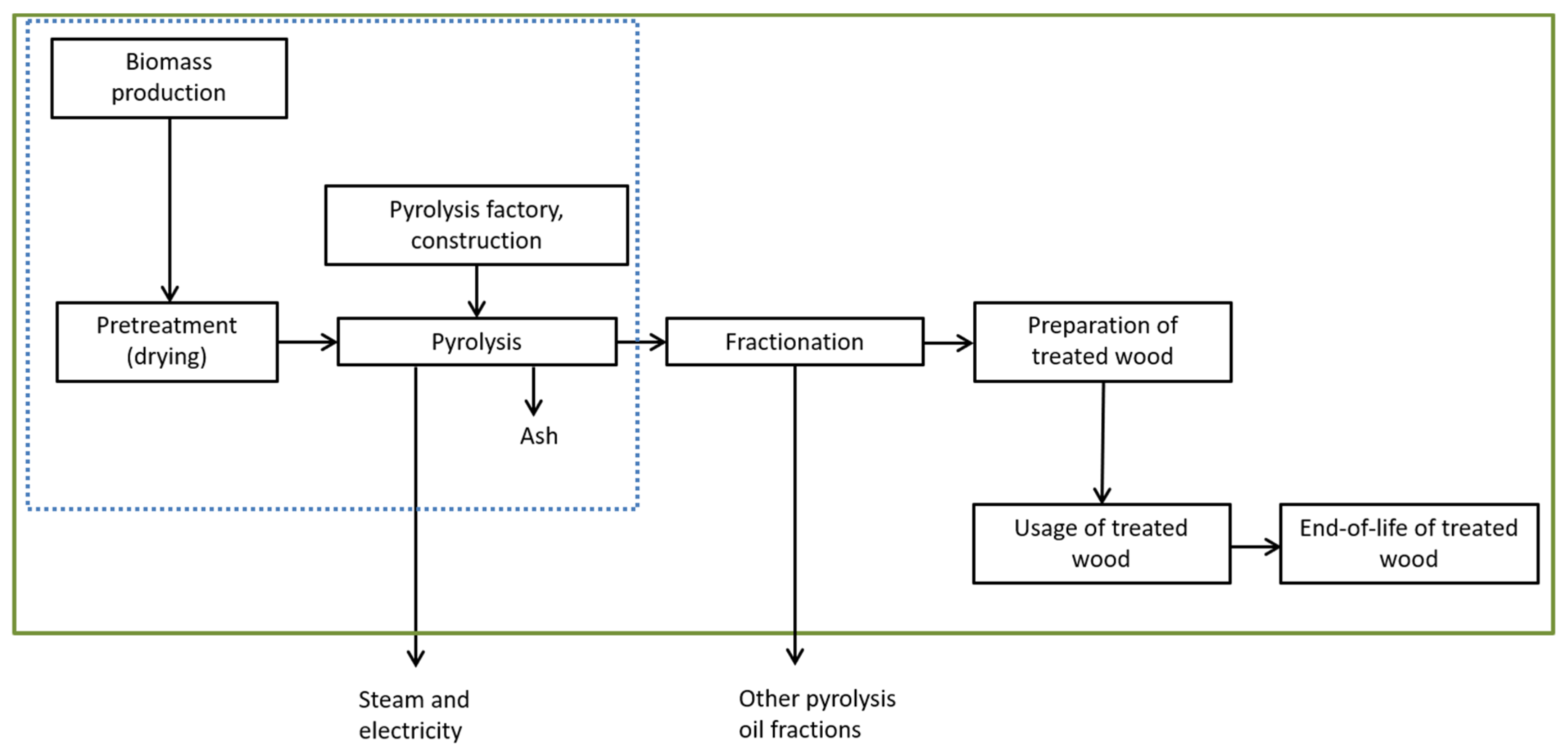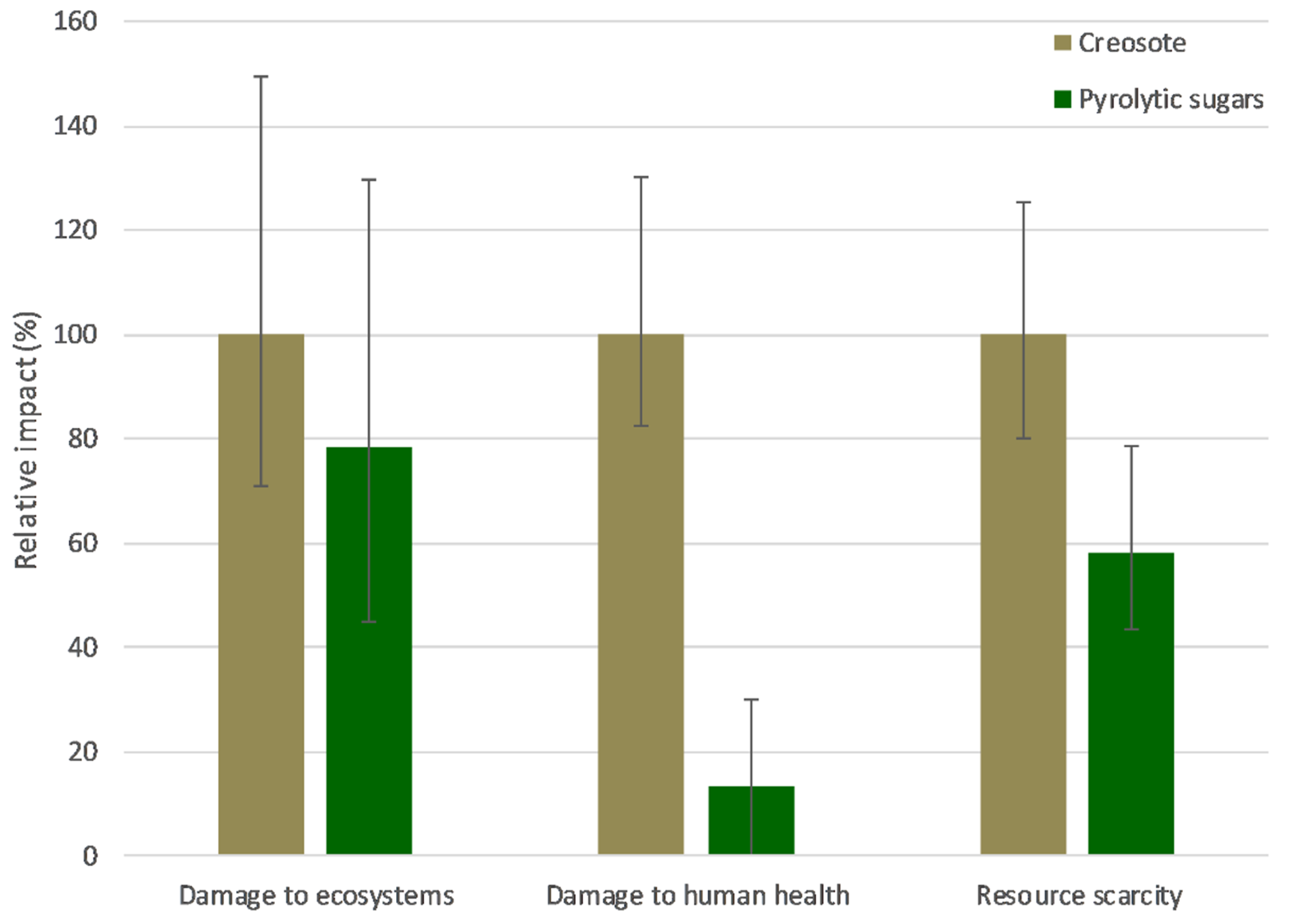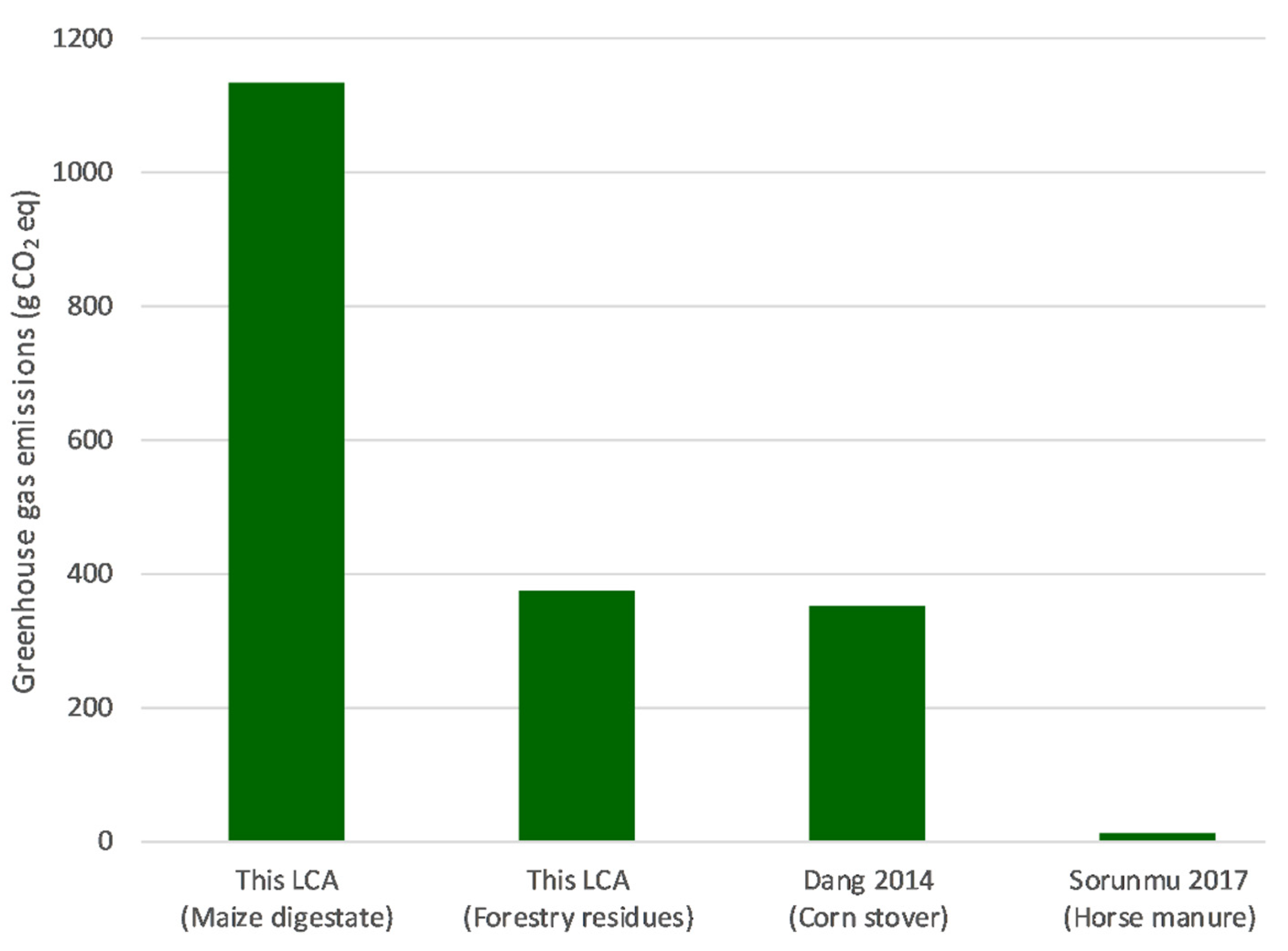Life Cycle Assessment on a Biorefinery Approach to Pyrolysis Oil for Wood Modification Treatment
Abstract
1. Introduction
2. Materials and Methods
3. Results
3.1. Impact of the Use of Different Biomass Feedstocks on Pyrolysis Oil in a Cradle to Gate Analysis
3.2. Impact of Wood Modification Treatment by Using Pyrolysis Oil
3.3. Impact of the End of Life of Modified Wooden Poles
4. Discussion
5. Conclusions
Supplementary Materials
Author Contributions
Funding
Acknowledgments
Conflicts of Interest
References
- Murphy, B.L.; Brown, J. Environmental forensics aspects of PAHs from wood treatment with creosote compounds. Environ. Forensics 2005, 6, 151–159. [Google Scholar] [CrossRef]
- Gallego, E.; Roca, F.J.; Perales, J.F.; Guardino, X.; Berenguer, M.J. VOCs and PAHs emissions from creosote-treated wood in a field storage area. Sci. Total Environ. 2008, 402, 130–138. [Google Scholar] [CrossRef] [PubMed]
- Kielhorn, J.; Mangelsdorf, I.; Medicine, E. IPCS Concise International Chemical Assessment Document 62: Coal tar creosote. IPCS Concise Int. Chem. Assess. Doc. 2004, 58, 1–113. [Google Scholar]
- EC REGULATION (EU) No 528/2012 OF The European Parliament and of the Council of 22 May 2012 concerning the making available on the market and use of biocidal products. Off. J. Eur. Commun. 2000, 269, 1–15.
- Covino, S.; Fabianová, T.; Křesinová, Z.; Čvančarová, M.; Burianová, E.; Filipová, A.; Vořísková, J.; Baldrian, P.; Cajthaml, T. Polycyclic aromatic hydrocarbons degradation and microbial community shifts during co-composting of creosote-treated wood. J. Hazard. Mater. 2016, 301, 17–26. [Google Scholar] [CrossRef]
- Wang, X.; Kersten, S.; Prins, W.; Van Swaaij, W.P.M. Biomass Pyrolysis in a Fluidized Bed Reactor. Part 1: Literature Review and Model Simulations. Ind. Eng. Chem. Res. 2005, 44, 8773–8785. [Google Scholar] [CrossRef]
- Meier, D.; van de Beld, B.; Bridgwater, A.V.; Elliott, D.C.; Oasmaa, A.; Preto, F. State of the art of fast pyrolysis in IEA bioenergy member countries. Renew. Sustain. Energy Rev. 2013, 20, 619–641. [Google Scholar] [CrossRef]
- Mohan, D.; Pittman, C.U.; Steele, P.H. Pyrolysis of wood/biomass for bio-oil: A critical review. Energy Fuels 2006, 20, 848–889. [Google Scholar] [CrossRef]
- Bridgwater, A.V. Review of fast pyrolysis of biomass and product upgrading. Biomass Bioenergy 2012, 38, 68–94. [Google Scholar] [CrossRef]
- Venderbosch, R.H. Thermochemical Processing of Biomass; Brown, R.C., Ed.; John and Wiley and Sons: Hoboken, NJ, USA, 2018; ISBN 9781119417576. [Google Scholar]
- BTG-BTL TechnipFMC and BTG-BTL to Build Bio-Oil production in Sweden. Available online: https://www.btg-btl.com/en/company/news/news/article?id=137 (accessed on 10 September 2019).
- Jung, S.H.; Koo, W.M.; Kim, J.S. Fast pyrolysis of creosote treated wood ties in a fluidized bed reactor and analytical characterization of product fractions. Energy 2013, 53, 33–39. [Google Scholar] [CrossRef]
- Bolin, C.A.; Smith, S.T. Life Cycle Assessment of Creosote-Treated Wooden Railroad Crossties in the US with Comparisons to Concrete and Plastic Composite Railroad Crossties. J. Transp. Technol. 2013, 3, 149–161. [Google Scholar] [CrossRef][Green Version]
- Iribarren, D.; Peters, J.F.; Dufour, J. Life cycle assessment of transportation fuels from biomass pyrolysis. Fuel 2012, 97, 812–821. [Google Scholar] [CrossRef]
- Peters, J.F.; Iribarren, D.; Dufour, J. Simulation and life cycle assessment of biofuel production via fast pyrolysis and hydroupgrading. Fuel 2015, 139, 441–456. [Google Scholar] [CrossRef]
- Dang, Q.; Yu, C.; Luo, Z. Environmental life cycle assessment of bio-fuel production via fast pyrolysis of corn stover and hydroprocessing. Fuel 2014, 131, 36–42. [Google Scholar] [CrossRef]
- Sorunmu, Y.E.; Billen, P.; Elkasabi, Y.; Mullen, C.A.; Macken, N.A.; Boateng, A.A.; Spatari, S. Fuels and Chemicals from Equine-Waste-Derived Tail Gas Reactive Pyrolysis Oil: Technoeconomic Analysis, Environmental and Exergetic Life Cycle Assessment. ACS Sustain. Chem. Eng. 2017, 5, 8804–8814. [Google Scholar] [CrossRef]
- Gebreslassie, B.H.; Slivinsky, M.; Wang, B.; You, F. Life cycle optimization for sustainable design and operations of hydrocarbon biorefinery via fast pyrolysis, hydrotreating and hydrocracking. Comput. Chem. Eng. 2013, 50, 71–91. [Google Scholar] [CrossRef]
- European Commission Joint Research Centre Institute for Environment and Sustainability. Framework and Requirements for Life Cycle Impact Assessment Models and Indicators; Publications Office of the European Union: Luxembourg, 2010; ISBN 9789279175398. [Google Scholar]
- O’Keeffe, S.; Franko, U.; Oehmichen, K.; Daniel-Gromke, J.; Thrän, D. Give them credit-the greenhouse gas performance of regional biogas systems. GCB Bioenergy 2019, 11, 791–808. [Google Scholar] [CrossRef]
- Wang, H.; Wang, L.; Shahbazi, A. Life cycle assessment of fast pyrolysis of municipal solid waste in North Carolina of USA. J. Clean. Prod. 2015, 87, 511–519. [Google Scholar] [CrossRef]
- Han, J.; Elgowainy, A.; Dunn, J.B.; Wang, M.Q. Bioresource Technology Life cycle analysis of fuel production from fast pyrolysis of biomass. Bioresour. Technol. 2013, 133, 421–428. [Google Scholar] [CrossRef]
- Hsu, D.D. Life cycle assessment of gasoline and diesel produced via fast pyrolysis and hydroprocessing. Biomass Bioenergy 2012, 45, 41–47. [Google Scholar] [CrossRef]
- Hauschild, M.; Goedkoop, M.; Guinee, J.; Heijungs, R.; Huijbregts, M.; Jolliet, O.; Margni, M.; De Schryver, A. Recommendations for Life Cycle Impact Assessment in the European Context; Publication Office of the European Union: Luxemburg, 2011. [Google Scholar] [CrossRef]
- Kohler, M.; Kunniger, T. Emissions of polycyclic aromatic hydrocarbons (PAH) from creosoted railroad ties and their relevance for life cycle assessment (LCA). Holz Roh Werkst. 2003, 61, 117–124. [Google Scholar] [CrossRef][Green Version]
- Otten, M.B.J.; Bergsma, G.C. Beter één AVI met een hoog rendement dan één dichtbij. 2010. Available online: https://www.ce.nl/publicaties/1096/beter-een-avi-met-een-hoog-rendement-dan-een-dichtbijhoeveel-transport-van-afval-is-nuttig-voor-een-hoger-energierendement (accessed on 10 September 2019).
- Huijbregts, M.A.J.; Steinmann, Z.J.; Elshout, P.M.F.; Stam, G.; Verones, F.; Vieira, M.D.M.; Zijp, M.; van Zelm, R. ReCiPe 2016: A Harmonized Life Cycle Impact Assessment Method at Midpoint and Enpoint Level-Report 1: Characterization; National Institute for Public Health and the Environment: Bilthoven, The Netherlands, 2016; p. 194. [Google Scholar]
- Brandón, M.G.; Juárez, M.F.-D.; Insam, H. D6.3 Ash Characterization. 2017. Available online: https://www.residue2heat.eu/d6-3-ash-characterization/ (accessed on 10 September 2019).




| Amount Sent to Landfill | Difference in Impact to Ecosystems (Species × Year) | Difference in Impact to Human Health (DALY 1) | Difference in Impact Resource Scarcity (USD 2013 2) |
|---|---|---|---|
| 1% | 0.52 × 10−7 | 4.71 × 10−5 | 0.40 |
| 50% | 0.42 × 10−7 | 4.34 × 10−5 | 0.35 |
| 99% | 0.32 × 10−7 | 3.97 × 10−5 | 0.29 |
© 2019 by the authors. Licensee MDPI, Basel, Switzerland. This article is an open access article distributed under the terms and conditions of the Creative Commons Attribution (CC BY) license (http://creativecommons.org/licenses/by/4.0/).
Share and Cite
Spekreijse, J.; Weide, T.; Hageman, S.P.W.; Reumerman, P.; Wetter, C.; Brügging, E.; Vis, M. Life Cycle Assessment on a Biorefinery Approach to Pyrolysis Oil for Wood Modification Treatment. Appl. Sci. 2019, 9, 4233. https://doi.org/10.3390/app9204233
Spekreijse J, Weide T, Hageman SPW, Reumerman P, Wetter C, Brügging E, Vis M. Life Cycle Assessment on a Biorefinery Approach to Pyrolysis Oil for Wood Modification Treatment. Applied Sciences. 2019; 9(20):4233. https://doi.org/10.3390/app9204233
Chicago/Turabian StyleSpekreijse, Jurjen, Tobias Weide, Simon P.W. Hageman, Patrick Reumerman, Christof Wetter, Elmar Brügging, and Martijn Vis. 2019. "Life Cycle Assessment on a Biorefinery Approach to Pyrolysis Oil for Wood Modification Treatment" Applied Sciences 9, no. 20: 4233. https://doi.org/10.3390/app9204233
APA StyleSpekreijse, J., Weide, T., Hageman, S. P. W., Reumerman, P., Wetter, C., Brügging, E., & Vis, M. (2019). Life Cycle Assessment on a Biorefinery Approach to Pyrolysis Oil for Wood Modification Treatment. Applied Sciences, 9(20), 4233. https://doi.org/10.3390/app9204233






